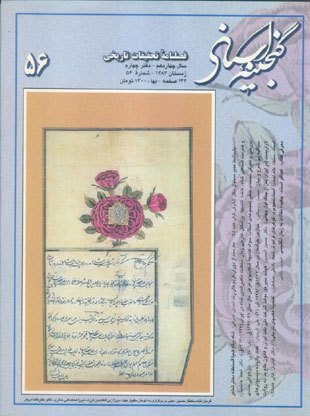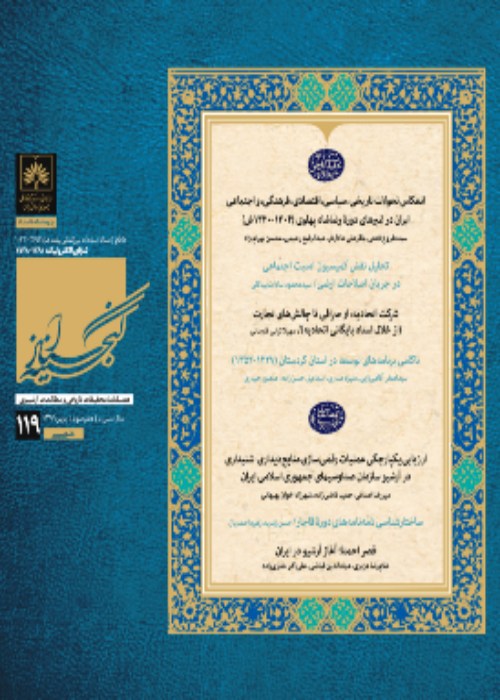فهرست مطالب

فصلنامه گنجینه اسناد
پیاپی 56 (زمستان 1383)
- 144 صفحه، بهای روی جلد: 13,000ريال
- تاریخ انتشار: 1383/12/20
- تعداد عناوین: 14
-
صفحه 6
-
صفحه 49
-
صفحه 112
-
صفحه 119
-
صفحه 131
-
صفحه 133
-
صفحه 142
-
Page 6In this record that remained from Karim Khan-e-Zand Era, Mirza Mohammad-Ali Sadr, one of the greatest cleric authorities, recommended to deliver some goods and money annually to Mirza Abd-ol-Ghaffar Qazvini for his services. He was one of the Qazvin governmental agents. These things gave him for preserving the Sacred Shrines of Qazvin.
-
Page 8Shah Beygom, Fath-ali Shah’s seventh daughter, was born in 1799. Her nickname was Zia-ol- Saltaneh. She was enjoyed his support and love and was very beautiful. She learnt from several teachers and became a witty, talented poet and had experienced in calligraphy, painting, sewing and other arts.She was her father’s confidant and wrote his confidential correspondence. In 1835, Zia-ol- Saltaneh married Mirza Masoud Ansari Garmroudi, the Minister of Foreign Affairs of Mohammad Shah and had two daughters and two sons. She died in 1873, while lived near Holy Shrines. Six pages are enclosed. One of them is concerning to selling a house of Zia-ol-Saltaneh in Sanglaj Avenue in Tehran and the others are related to the conveyance and rent of her gardens and farms.
-
Page 29As it has been recorded in history, in Qajar era, specially in Naseri’s government some of the European physicians were employed as Hakim-Bashi (the head-physician), and after Darolfonoon’s inauguration, some of them were taught medicine. Some of these physicians practice medicine in Iran. This article introduces the most famous physicians, and then gives detailed biographies of Dr. Hinchey, Fagrin (from Sweden), and Dr. Charles (from England). The author refers that a number of these physicians came to Iran along with missionaries. This article introduces, over than 20 European physicians who came to Iran between 1831 -1896 and have medical services.
-
Page 39In this article, the author examines the copy of complaints and petitions’ booklet of the years 1874-1875. This booklet is the copy of “Sandoq-e-Edalat’s” (a box that people have their complaints on it) report that written by its agent in those years and shows the social and judgement situation of Iran in Qajar era.In this collection, there are 712 copeis of complaints in 8 months from different cities. Most of them related to Qazvin by 120 complaints and the least one is from Lahijan by 6 complaints. There are 121 requests on appointing salary and wage and 94 requests on tax-exempt or tax- reduction, and also there are some of responses and reports that prepared for them.
-
Page 44This article is transcription of a record that was written in Siaq in the last years of Naseri’s government, and consisting of revenues, expenditures, and financial accounts of Anoshiravan Mirza Zia’oddoleh in 1311 and 1313 H.A./1894 and 1896 A.D. This Qajar’s Prince, spent some years of his life to governing in different provinces. From its content, the author understands that these financial accounts are related to Semnan province.The author intends to attract the attention of the history researchers to this fact that Siaq is a language of many financial and statistical records belongs to the recent 200 years by introducing and transcribing a siaq record. Now, it is the time that we pay more attention to this part of record knowledges and learning it.
-
Page 49This article is the second part of Khorasan Schools in 1919 that has been published in Ganjineh Asnad. In that article, the author gave an introduction about schools’ foundation in Khorasan and Meshed, in particular, and in this volume, he considers the history of Meshed suburbs districts such as: Torqabeh, Radakan, Chenaran, Toroq and other schools of Khorasan provinces such as: Boujnord, Shirvan, Qouchan, Sarakhce, Torbat-e-Hidarieh, Sabzevar, Neyshabour, Gonabad, Kashmar and Birjand. The author provides detailed information about: schools’ names, date of their foundations, educational grades, students, the oldest and youngest student in each grades, ownership situation, annual budgets, teachers’ names, the lessons, teachers’ ages, employment period, salaries, the equipments of schools, and finally, the result of ministry of education’s inspector report.
-
Page 80The French Lazarist missionaries and other religious groups from Russia and England came to Iran after the first group of American religious missionaries’ arrival in August, 1834 and began their work among the Iranian Christian. After the First World War, Semetic, the Pop’s representative came to Tabriz in 1303H./ December of 1924 for researching about the Catholic residents in Iran. This article is a brief report about the efforts of Pop’s representative and his success in the establishment of religious schools in Iran.
-
Page 90In the beginning of Dr. Mossaddeq government’s foundation, a board consisting of 5 delegates from Senate, 5 delegates from National Consultative Assembly and Economy Minister or his deputy was formed for the execution of nationalizing the Iranian Oil Industry’s law. In 2nd of June 1951, by government suggestion and board’s approval, a tripartite group formed as provisional board of directors of Oil Company and left for Khuzestan. Aforesaid board succeeded to its mission in 20 th June in Khuzestan. The consequent of this mission was that they can control oil reserves and industrial establishment and other related organizations.In this article, the beginning and executing of these government affairs considered and the author offers related records that each of them display how these missions take place and they challenged with problems.
-
Page 112National Archives of each country is the most secure and trusted place that has the responsibilities of collection, identification, preservation, and making them accessible for researchers. Records are the center of the organizations’ affairs and considered as the invaluable experiments of governments.Certainly, cultural and research promotion in each society will require to pay special attention to that country’s documents and records.This article, introduces a brief description about the importance of national records, explains some of effective factors in national archives’development such as people’s participation, Information, employees’ training, and regional archives’ establishment, in the meanwhile.


